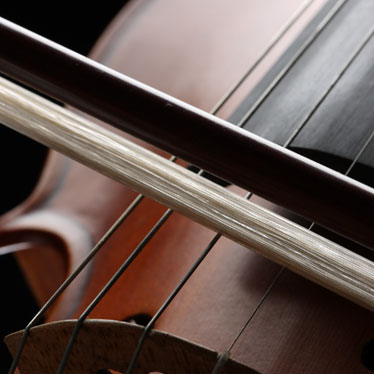Smackdown: Synthetic vs. Natural Bow Hair

String musicians today have instrument options that simply weren’t available 20 or 50 years ago. Because of their history, string instruments have always been made using basically the same materials and methods, and it hasn’t changed for centuries. However, the organic materials used to fashion fine instruments are no longer the only alternative for production.
Over the past few decades, advancements in manufacturing processes and technology have opened new possibilities for Luthiers. Instead of using natural materials, many new synthetic products are not only more effective, they provide an acceptable substitution for vegan musicians who want their career to line up with their convictions.
For example, there are instruments made with specialized glue that isn’t harvested from animal hides. However, the effectiveness of the adhesive is much less than desired, so it’s very difficult to find a truly “vegan” string instrument. Other advancements in string production have been successful, though. There are a number of synthetic strings available that deliver the rich, resonant sound of gut without being as susceptible to changes in the temperature and humidity.
In addition, composite fiber bows are constructed of synthetic materials that guard against warping, while mirroring stiffness, balance and responsiveness of pernambuco bows. They also have greater strength and longevity.
Likewise, there have been innovations in the area of horsehair for string instrument bows. In the same way that hide glue is made, bow hair is generally harvested from slaughtered horses, and until a couple of years ago, there really hasn’t been any alternative that worked.
Coruss Synthetic Bow Hair
The Orchestre de Chambre de Toulouse, in cooperation with engineers from the French Institute of Textile and Clothing, has developed and own Coruss, a synthetic bow hair that actually mimics the texture and performance of horsehair. Played for 5 years by musicians of Orchestre de Chambre de Toulouse, Coruss is turning heads among famous string musicians. Before you decide to try it, it’s important to understand exactly how it measures up against natural bow hair. The following comparisons can help you.
Weather Sensitivity
Horsehair – reacts to changes in the environment, specifically to humidity change, causing the hair to shorten and lengthen. This means that your bow hair must be continually loosened and tightened to play. If you accidentally forget to relieve the tension or have had your bow re-haired for a high humidity environment and the humidity drops, the strands are strong enough to warp your wooden bow – or even break the bow. Inversely, going from dry to humid environment, you may not be able to tighten it to the right tension to be able to play efficiently.
Synthetic Hair – maintains its length regardless of the weather conditions because it is impervious to the problems that characterize organic materials.
Breakage
Horsehair breaks easily under certain conditions. Common problems include:
- Hair is poor quality (or simply not from a white stallion) or too old, which is why you have to keep tightening it
- Hair is weaker and thinner at the tip, like human hair
- Longevity can be reduced because of sweaty/acidic perspiration
Synthetic Hair – is extremely durable and practically eliminates breakage and premature wear. It has the same fiber diameter at the tip and at the frog, and simply needs to be cleaned up whenever getting marked at the frog by sweat or rosin residue. This high resistance to breakage will allow much more subtle sound production than a prematurely reduced hank of hair.
Consistency
Horsehair – cannot be stored for long periods without decaying in some manner or being attacked by bow bugs. Because it’s organic, it also features irregularities and tangled kinks that impact the sound you generate.
Coruss Synthetic Hair – was created with the problems of horsehair in mind. Developers in France wanted to eliminate the imperfections related to natural hair and they formulated a material that acts like horsehair in the way it receives rosin and reacts to the strings, but without any of the issues.
Performance
Horsehair – has been around for centuries and is responsible for great sound when the best quality is used.
Coruss Bow Hair – performs considerably better than traditional horsehair. The dynamic range is exceptional, offering rich resonance for a full sound. Plus, it delivers excellent response and feel.
Application
There are absolutely no differences between synthetic Coruss Hair and horsehair related to the re-hairing and rosining process. Luthiers can place Coruss bow hair on any type of bow, including beginner and advanced models. It is also rosined identically to horsehair, so there’s no new procedure for musicians to learn. If anything, avoid over rosining it, as it will create initial unwanted bow noise. If so, simply wipe off rosin excess. Because Coruss is synthetic, luthier may use 95% of what they buy, versus 70 to 80% at best for horsehair.
Coruss bow hair functions exactly like horsehair, minus the problems that surround organic materials, which makes it an awesome substitute for vegan musicians who want their instruments to match their lifestyle. However, it’s also a fantastic alternative for any player who wants to enhance their sound. Plus, the color options are really cool.
"I get more sound without working so hard…the response [is] better, the notes are more immediate." –Tim Older, Double-Bassist, BBC National Orchestra of Wales
While retaining the artistry of fine craftsmanship, this French innovation has provided a way to reduce many of the most common issues related to organic bow hair. With a number of professionals raving about it, you’ll never regret trying it on your instrument's bow.


